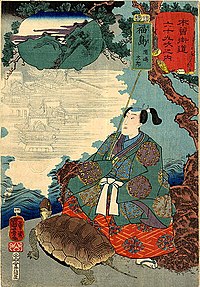

History
The name Urashima Taro first appears in the 15th century (the Muromachi period), in the book Otogizōshi, but the story is much older, dating back to the 8th century (the Nara Period). These older books, such as Nihon Shoki, Man'yōshū [2] and Tango no Kuni Fudoki (丹後国風土記) refer to Urashima Taro as Urashimako, though the story is the same. This represents a change in Japanese naming customs; in the previous eras, -ko (child) was used for both male and female names, while in later times it was mostly a female name element, replaced with -tarou (great youth) in boys' names.
One day a young fisherman named Urashima Tarō is fishing when he notices a group of children torturing a small turtle. Tarō saves it and lets it to go back to the sea. The next day, a huge turtle approaches him and tells him that the small turtle he had saved is the daughter of the Emperor of the Sea, who wants to see him to thank him. The turtle magically gives Tarō gills and brings him to the bottom of the sea, to the Palace of the Dragon God (Ryūgū-jō). There he meets the Emperor and the small turtle, who was now a lovely princess, Otohime.
Urashima Tarō illustration by Edmund Dulac
Tarō stays there with her for a few days, but soon wants to go back to his village and see his aging mother, so he asks Otohime permission to leave. The princess says she is sorry to see him go, but wishes him well and gives him a mysterious box called tamatebako which she tells him never to open. Tarō grabs the box, jumps on the back of the same turtle that had brought him there, and soon is at the seashore.
When he goes home, everything has changed. His home is gone, his mother has vanished, and the people he knew are nowhere to be seen. He asks if anybody knows a man called Urashima Tarō. They answer that they had heard someone of that name had vanished at sea long ago. He discovers that 60 years have passed since the day he left for the bottom of the sea. Struck by grief, he absent-mindedly opens the box the princess had given him, from which burts forth a cloud of white smoke. He is suddenly aged, his beard long and white, and his back bent. From the sea comes the sad, sweet voice of the princess: "I told you not to open that box. In it was your old age ..." This story bears a striking similarity to many other tales, including that of Oisín.
As always with folklore, there are many different versions of this extremely famous story. In one, for example, after he turned into an old man he took the body of a crane, in another he ate a magic pill that gave him the ability to breathe underwater. In another version, he is swept away by a storm before he can rescue the turtle. Also, there is a version in which he dies in the process of aging (his body turns into dust), as no one can live 300 years.








Tidak ada komentar:
Posting Komentar